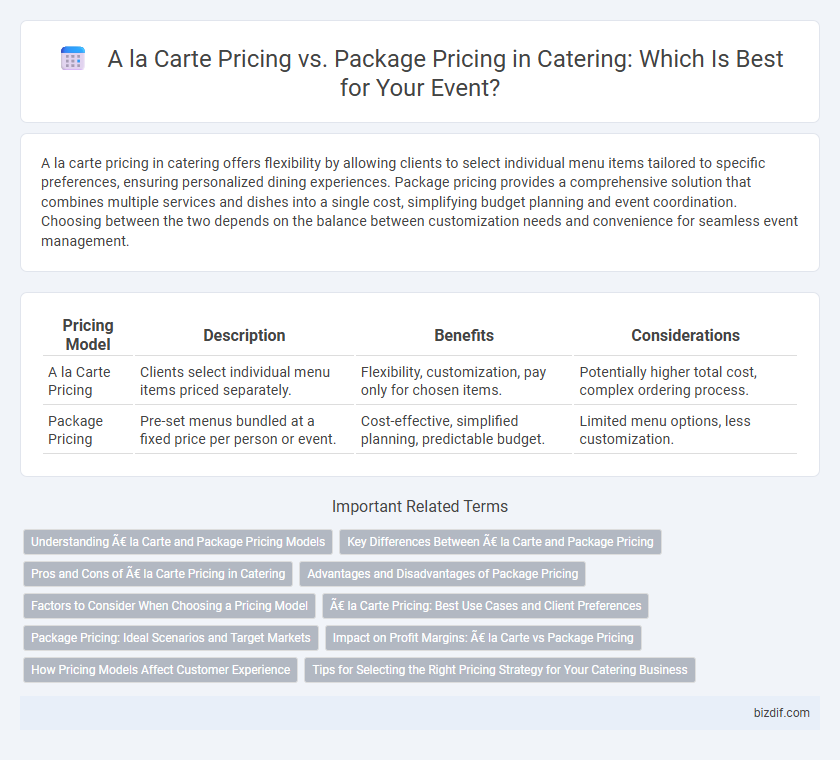A la carte pricing in catering offers flexibility by allowing clients to select individual menu items tailored to specific preferences, ensuring personalized dining experiences. Package pricing provides a comprehensive solution that combines multiple services and dishes into a single cost, simplifying budget planning and event coordination. Choosing between the two depends on the balance between customization needs and convenience for seamless event management.
Table of Comparison
| Pricing Model | Description | Benefits | Considerations |
|---|---|---|---|
| A la Carte Pricing | Clients select individual menu items priced separately. | Flexibility, customization, pay only for chosen items. | Potentially higher total cost, complex ordering process. |
| Package Pricing | Pre-set menus bundled at a fixed price per person or event. | Cost-effective, simplified planning, predictable budget. | Limited menu options, less customization. |
Understanding À la Carte and Package Pricing Models
A la carte pricing allows clients to select individual menu items, offering flexibility and customization tailored to specific preferences and dietary needs. Package pricing combines various services and menu options into a bundled rate, often providing cost savings and streamlined planning for events. Understanding these models helps caterers align offerings with client budgets and event objectives, enhancing satisfaction and operational efficiency.
Key Differences Between À la Carte and Package Pricing
A la carte pricing allows customers to select individual menu items with separate prices, offering flexibility and customization for specific preferences. Package pricing bundles multiple services or menu items into a single price, providing convenience and often better value for larger groups or events. Key differences include the level of customization, pricing transparency, and suitability for various event sizes and client needs.
Pros and Cons of À la Carte Pricing in Catering
A la carte pricing in catering allows clients to select individual menu items, providing flexibility and customization tailored to specific tastes and dietary needs; this approach often appeals to diverse groups with varied preferences. However, this pricing model can lead to higher overall costs compared to package pricing, as individual item prices may accumulate without discounts normally afforded in bundled offers. Catering businesses may face challenges in inventory management and increased complexity in service delivery when using a la carte pricing, requiring meticulous coordination for seamless event execution.
Advantages and Disadvantages of Package Pricing
Package pricing in catering offers clients a clear, all-inclusive cost that simplifies budgeting and reduces unexpected expenses, making it ideal for events with fixed requirements. However, it limits customization, potentially leading to paying for unwanted services or menu items, which may not suit diverse client preferences. This approach benefits vendors by streamlining operations and inventory management but can deter customers seeking flexibility or unique menu choices.
Factors to Consider When Choosing a Pricing Model
When selecting between a la carte pricing and package pricing for catering services, factors such as budget flexibility, event type, and guest preferences play a crucial role. A la carte pricing offers customization and control over individual menu items, ideal for clients seeking specific dishes or dietary accommodations. Package pricing simplifies budgeting and planning by bundling services, often preferred for larger events where consistency and convenience are priorities.
À la Carte Pricing: Best Use Cases and Client Preferences
A la carte pricing in catering is ideal for clients seeking flexibility and customization, allowing selection of individual menu items based on specific tastes and dietary requirements. This pricing model suits events where guests have diverse preferences, such as weddings with mixed-age groups or corporate gatherings with varied dietary restrictions. Clients who prioritize control over budget allocation and menu variety often prefer a la carte pricing to maximize satisfaction and reduce food waste.
Package Pricing: Ideal Scenarios and Target Markets
Package pricing in catering is ideal for large events such as weddings, corporate functions, and parties where clients seek convenience and clear budgeting. This pricing model appeals to target markets that prefer fixed costs with predefined menus, including event planners, busy professionals, and organizations managing group meals. It simplifies decision-making by offering curated options that balance quality and cost-effectiveness, making it highly attractive for clients aiming to avoid unexpected expenses.
Impact on Profit Margins: À la Carte vs Package Pricing
A la carte pricing allows caterers to charge individually for each item, offering higher profit margins on premium selections but risking lower overall revenue due to unpredictability in customer choices. Package pricing bundles multiple menu items into a fixed rate, streamlining costs and maximizing profit certainty by encouraging higher volume sales and reducing waste. Strategic use of both pricing models can optimize profit margins by balancing customization and cost control in catering services.
How Pricing Models Affect Customer Experience
A la carte pricing allows customers to customize their meals by selecting individual dishes, offering flexibility and control over their dining experience. Package pricing simplifies decision-making by bundling multiple services or courses into a single cost, often providing better value and convenience. The choice between these pricing models influences customer satisfaction, with a la carte appealing to those seeking personalization and package pricing attracting clients who prioritize ease and cost-effectiveness.
Tips for Selecting the Right Pricing Strategy for Your Catering Business
When selecting the right pricing strategy for your catering business, analyze your target market's preferences and budget flexibility to decide between A la Carte Pricing and Package Pricing. A la Carte Pricing offers customization and appeals to clients seeking specific menu choices, while Package Pricing provides simplicity and value through bundled services. Evaluate factors such as cost control, operational efficiency, and customer expectations to optimize profitability and enhance client satisfaction.
À la Carte Pricing vs Package Pricing Infographic

 bizdif.com
bizdif.com